Bdelloid rotifers are world champions when it comes to survive desiccation. This can be demonstrated even at home if there is a garden with a bowl of water which may serve as birdbath in summer. Especially the last summers in Western Europe have been very hot, so the water may also evaporate for some time. There are some typical rotifers that can be observed in such birdbaths. |
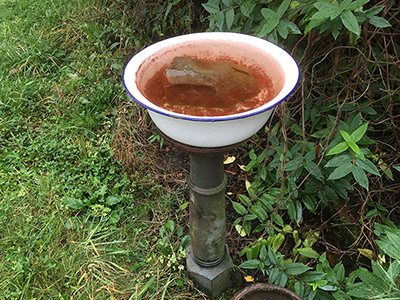 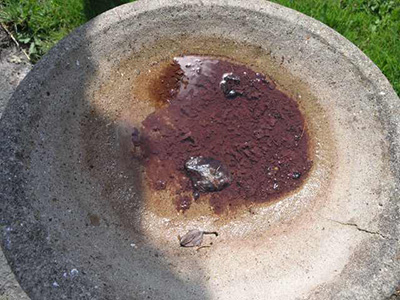 |
| In the course of the time the ground of such bird-baths fills with a brown-red mass; these are chlorophytes (Haematococcus pluvialis), with which both the spores and the movable flagellates are colored red by a carotenoid, the Astaxanthin. A bdelloid rotifer is often associated with this alga -also in literature-: Philodina roseola, which is typically recognizable by its red stomach. The red coloration of the stomach, but also the not so intense red color of the integument, is often explained by the fact that this rotifer feeds on the red chlorophyte Haematococcus. But it is not quite that simple: for example, in the bird bath on the upper left you can find a lot of Haematococcus and also bdelloid rotifers, but these rotifers are with no exception without a red stomach, and their integument is only slightly reddish. This rotifer is Philodina acuticornis. It is probably not able to transport the relatively large flagellates of Haematoccoccus (the aplanospores are much too large anyway) through the mastax. Instead, P. acuticornis feeds on smaller algae such as Acutodesmus sp., which are also found in such a bird bath, but are rather inconspicuous in the microscopic picture because of their small size and light green color. |
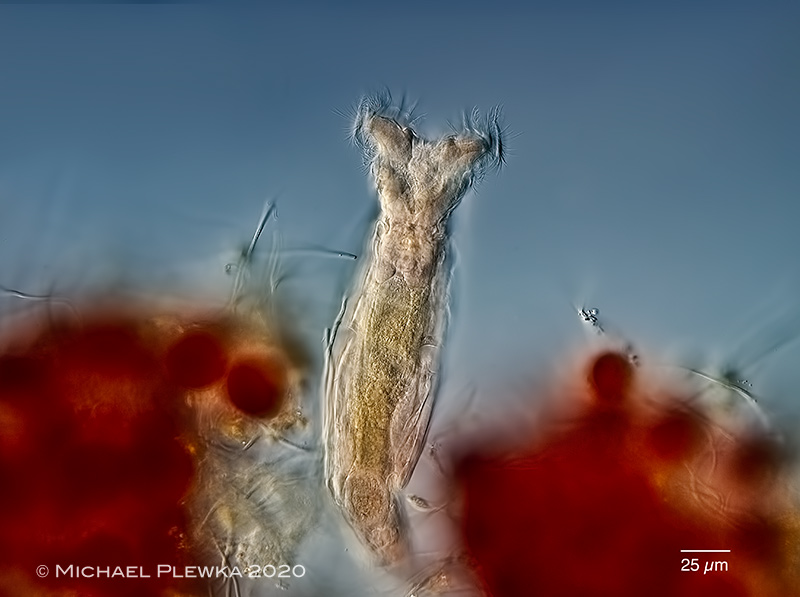 |
| Philodina acuticornis; inhabitant of the above (left) birdbath. |
| |
|
From the above mentioned example it becomes clear that in such bird baths there are other algae or cyanobacteria species besides Haematococcus (the latter is very conspicuous because of its red color), which are much more inconspicuous. In another bird bath (unfortunately no photograph is available), Haematococcus was also found; in there the rotifer Philodina roseola with a red stomach was also found, but this rotifer species fed at least also on green chlorophytes (Oocystis sp.) and cyanobacteria. Another bdelloid species was also found in this bird bath, which also could only be observed eating green chlorophytes and cyanobacteria: Abrochtha intermedia. Both species had a red stomach. Of course this observation is no proof that the red color of these animals is not from the Haematococcus algae. But the habitats presented in the following part show that the relationship between the color of the bdelloid rotifers and their food is somewhat more complex than one might initially assume on the basis of the introduced bird-baths. |
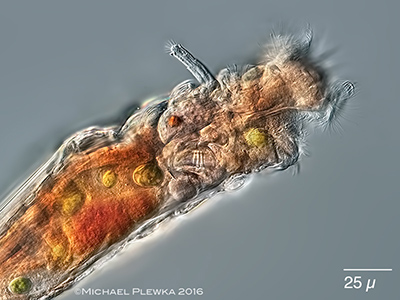 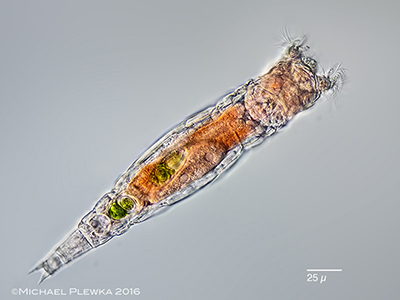 |
| Philodina roseola (left) and Abrochtha intermedia (right) feeding on small green algae (Oocystis sp.) |
| |
The coastal landscape of Brittany, especially in the north, is characterized by granite rocks on the top of which there are often dents that can fill with water. (lithotelmata). In these ephemeral puddles some special rotifers were found, whose characteristic combinations of traits do not correspond to those of the taxa described in the literature so far.
There are two kinds of puddles existing at the coastline: the first ones are enriched by the waves and also by the associated spray with saltwater, these shall be ignored here.
The puddles in question here are those puddles that are located above the break-off edge and that are fed with rainwater. Especially in the two hot summers of 2019 and 2020, these puddles have been very often dried out, but then they were fed again by rain. Sometimes the puddles are filled by dark sediment/ detritus, the temperatures become quite high due to the intense sunshine. In contrast to bird baths or rock puddles in Germany /NRW the temperatures in winter in Brittany are above 0 degrees Celsius, so that no frost occurs. Some of the found taxa are very conspicuous by their red color of both the integument and the stomach contents. The green algae Haematococcus pluvialis could not be detected in any of the samples. These puddles are enriched with biomass by flower parts and pollen from the surrounding meadow plants. |
 |
The rotifers found in these lithotelmata are bdelloid rotifers with one exception: in a, however somewhat shaded, rock puddle a large amount of the monogonont rotifers Epiphanes senta was found, a species that can also be found in NRW in ephemeral path puddles and water-filled footprints of cattle.
The following images show some taxa of the rotifers found in these lithotelmata: |
|
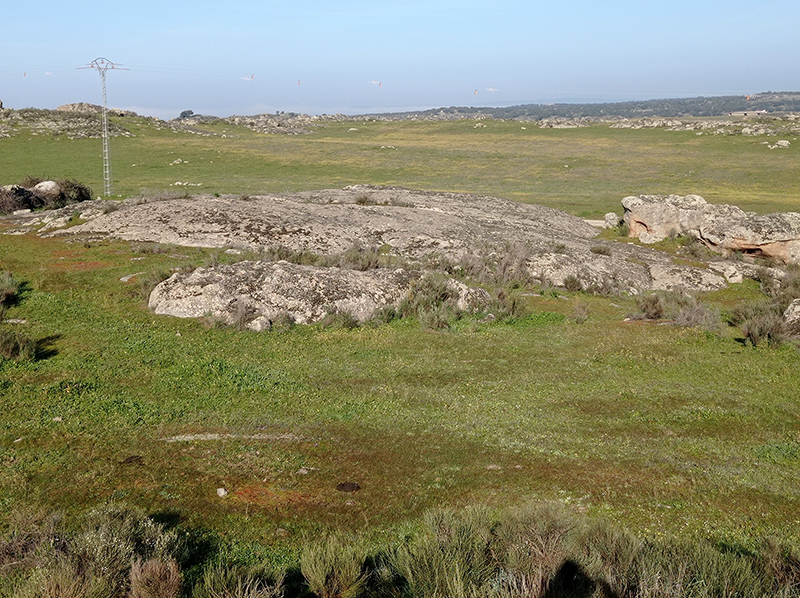 |
Pretty sensational is the observation of a conspicuous bdelloid rotifer that looks like Philodina alata (see image below) in some lithotelmata of granite rocks in Cáceres province, Spain from 2024 (images courtesy of N. Benvenuty, Spain.). Up to now Philodina alata had only been found in Antarctica and has been regarded an endemic species. |
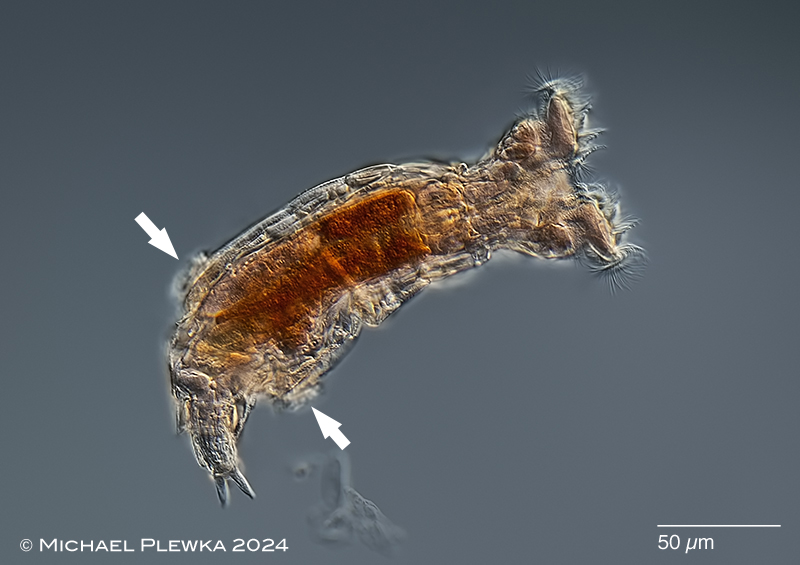 |
| Philodina alata; the arrows point to the lateral bolsters on the trunk that are characteristic for this species. |
| |
 |
|
|
| |
| |
| |
| |
| |
|
|
|
| |